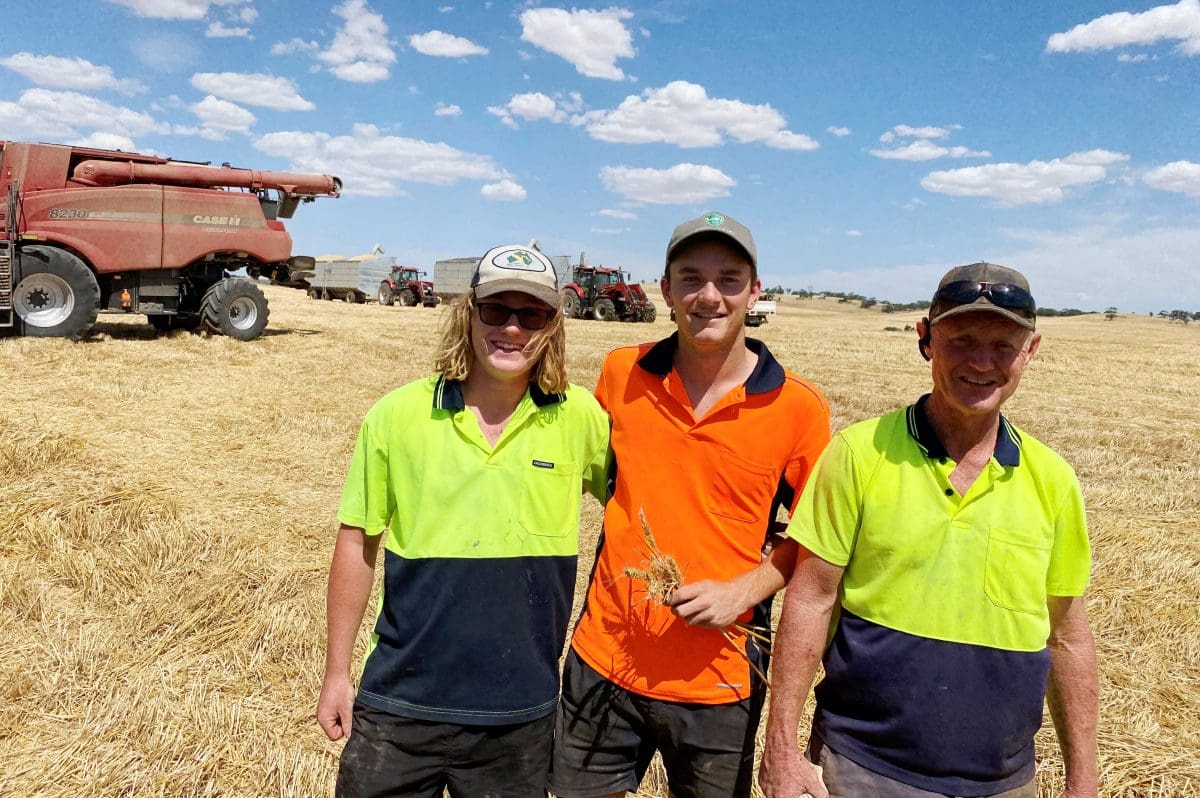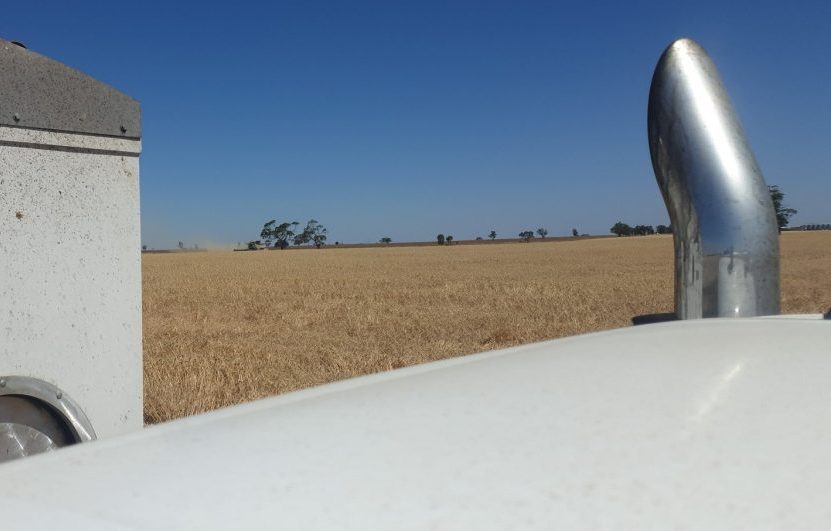
Dave Parkinson with son Noah (left) and nephew Ben Parkinson finish a paddock of Scepter wheat at Auburn in SA’s Mid North and have at least a fortnight more of harvest to go.
DURUM crops have posted some bumper yields and delivered better-than-expected quality for growers in south-eastern Australia after one of the wettest springs on record.
While durum grown in South Australia and Victoria primarily supplies domestic pasta manufacturing, durum tonnes surplus to local needs are likely to go to export.
The market has softened considerably in the past fortnight as exporters ingest the impact of a bigger and better crop than earlier expected from the extremely late harvest, and options for selling it along with the tonnage available out of northern NSW and southern Queensland.
The three durum grades are: DR1 for minimum 13pc protein; DR2 for 11.5-12.9pc protein, and DR3 of minimum 10pc protein, and most deliveries in NSW, Victoria and SA are understood to have made at least DR3 specs.
Australia’s annual durum production varies considerably, but around 400,000 tonnes seems likely, with big yields in SA and Victoria offsetting a troubled year for NSW.
Durum pips bread wheat at Auburn
In the Auburn-Saddleworth district of SA’s Mid North, Dave Parkinson and family crop 1500ha, with 210ha of durum planted this year, and bread wheat, canola and pulses filling the balance.
“This year, durum has won the race in terms yield and gross income,” Mr Parkinson said.
Durum has yielded 6.5t/ha, ahead of bread wheat on 5.5t/ha.
The mild and wet spring saw the family get both its headers rolling on December 11, well past the normal start time of November 23-24, and they will finish three weeks later than normal.
The family is usually staying at its shack on the River Murray on a water-skiing holiday by mid January, but flooding his impacted the building, and closed the river to recreational boating.
“Even if we’d finished harvest, we couldn’t get to the river anyway.”
Mr Parkinson said durum’s advantage probably came from its lateness, and the fact they sowed it into their best country following lentils and faba beans.
Durum is a staple in the Parkinsons’ rotation, and is part of the SA crop the state’s Department of Primary Industries and Regions estimated in November at 114,960t from 37,200ha, with 2022-23 production seen as up 12pc on the five-year average.
The Parkinsons sell all their durum on a contract basis to Adelaide pasta manufacturer San Remo at an agreed price posted early in the year, and deliver straight to the company’s Harley Milling site at Balaklava, around 40km away.
Mr Parkinson said up to one third of the farm’s expected bread-wheat production was forward sold during the growing season.
“We contracted APW on a multigrade contract at $470/t in the middle of the year.”
Being less than 120km from Port Adelaide means Mr Parkinson warehouses unsold grain straight off the header, and sells on spikes in the months following harvest.
N pays off in Victoria
At Kaniva in Victoria’s west Wimmera, Alwyn Dyer and family had durum and bread wheat yield 5-7t/ha, well up on the average of 4-4.5t/ha to put this harvest as one of their highest-yielding crops ever.
“We just finished harvesting durum a couple of days ago and it was alright,” Mr Dyer said.
“There was a bit of fungal staining, and some paddocks have been badly affected with waterlogging, but most people got 4-6t/ha.”
Grain Central understands the bulk of SA and Victorian durum is contracted on a per-hectare basis to Harley Milling, and the contract contains an upper yield limit which many growers have breached.
“Most people will well exceed that.”
High yields have come despite the sodden spring making it difficult to top-dress with urea, and apply fungicides at the ideal time.
“We normally don’t get days and days of wet humid weather; our rainfall records would indicate we’ve never had a spring like it.
“We had 300mm in September, October and November, and the annual average for those months is 70mm.”
“We more often than that suffer from spring droughts.”
“Normally on a wet spring we’d expect durum to out-yield bread wheat, but not this year.”

Harvesting durum last week at the Dyer’s farm at Kaniva in Victoria. Photo: Jonathan Dyer
Mr Dyer said durum’s strong disease resistance meant they sprayed it once or not at all with fungicide, and this may have impeded yield in some paddocks., while bread wheats had up to three fungicide applications.
“We’re still happy with the way its panned out.”
“Our bread wheat averaged 6t/ha, and the usual average is 3.5-4t/ha.”
The Dyers had most of their bread wheat make protein of 11.5-12.5pc protein and H2, down on the normal H1, but better than expected given the season.
Mr Dyer said most of the district’s wheat has made ASW and APW, and theirs jagged H2 because of son Jonathan’s nitrogen calculations that were well timed with rain events.
“We threw a lot of urea out, and we had a lot of doubts about it, but it looks like it’s paid off.”
“We’ve had to spend so much on fertilisers at a horrific price.”
At $1300-$1500/t, nitrogen alone cost $400/ha across their 3000ha of cropping, with fungicide and MAP adding further to the heady input bill for the 2022-23 crop.
“It will be volume wise the biggest harvest we’ve ever had but financially I don’t think we’ll be better off.
“There is quite a bit of low-protein wheat around; people doubted the economics of spending money on nitrogen.”
The Dyers’ harvest started three weeks later than normal.
“If we finish this coming weekend, and that’s a big if, that will be 7-8 weeks of harvest; it’s been slow.”
Mixed bag in NSW
At Mullaley on the Liverpool Plains, Ross Durham targets a durum yield of 5t/ha, and this harvest achieved 4-4.5t/ha on country fallowed over summer.
Durum double-cropped into sorghum stubble was sown late, and yielded more like 2.5-3t/ha.
He said keeping fungicide and nitrogen up to crops was a challenge in the wet season, and the last urea application had to go on aerially.
Given the challenge of the season, Mr Durham felt grades were “not too bad”.
“We’ve probably got 75pc DR2, 15pc DR3, and 10pc DR1.”
“Some growers out there couldn’t nitrogen on, and struggled to get fungicide on, so they’ll be searching for a feed market.”
Bread wheat an average yield of 6t/ha yielded 10-15pc better than durum, and canola was the only other winter crop grown for the season.
Grain Central: Get our free news straight to your inbox – Click here

HAVE YOUR SAY